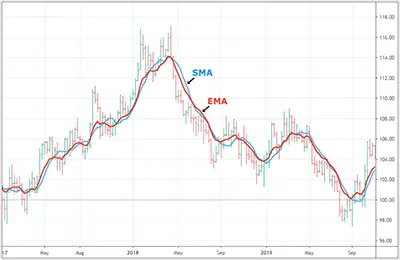Exponential Moving Average (EMA) Calculator
This easy to use exponential moving average (EMA) calculator will allow you to calculate a data set's exponentially weighted moving average.
To use the calculator, enter the data values, separated by line breaks, spaces, or commas, and click on the "Calculate" button.
Reference
The exponential moving average (EMA) is a form of moving average that is weighted towards giving more significance to the latest data points. The EMA is sometimes also called the exponentially weighted moving average.
If you have a list of data points in order of collection, you can calculate the EMA for every point up to the latest one. With an EMA, as you go back in your data set weights decrease by the constant factor α. Such cumulative moving averages are often employed to chart stock prices. Exponential averages are better at recognizing price changes. Below we see the recursive formula for EMA:
EMA today = α Price today + (1 − α) EMA yesterday
With EMA today representing current EMA value, EMA yesterday representing previous EMA value, Price today representing current price point, and α representing a constant between 0 and 1. Frequently, α is a function of a certain number of days n.
The most frequently employed function is α = 2 / (n + 1)
For example, the 9-day EMA of a sequence has α = 2/(9+1) = 2/10 = 0.2, and a 19-day EMA has α = 2/(19+1) = 2/20 = 0.1

Stock analysts frequently employ both EMA and SMA (simple moving average) for stock prices in order to follow trends regarding price rises or drops, which allows them to make predictions about future fluctuations. As with all moving averages, the high and low points on the EMA graph will show a degree of lag in comparison to original non-filtered data. The greater the n value is, the lower the α value becomes, and this results in a smoother graph.
